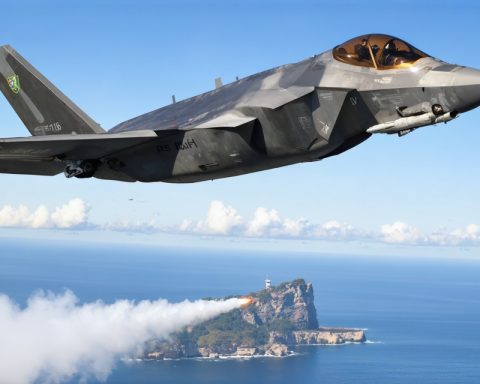- The global military aircraft Maintenance, Repair, and Overhaul (MRO) market is projected to reach $145 billion by 2034, driven by increased defense budgets and geopolitical tensions.
- Military aircraft MRO is crucial for ensuring safety, machine readiness, and performance under extreme conditions, especially with advanced fighter jets and avionics.
- The Asia-Pacific region is a key player in the market’s growth, motivated by modernization and regional defense parity efforts.
- Industry leaders like Rolls-Royce, GE Aerospace, and Raytheon Technologies are innovating MRO practices, emphasizing excellence and reliability.
- Next-generation aircraft, including UAVs, demand specialized MRO services, pushing the industry toward innovative solutions.
- A robust MRO pipeline is essential for national defense readiness and maintaining tactical superiority in the air.
An unprecedented wave is crashing across the global military aircraft Maintenance, Repair, and Overhaul (MRO) market, driven by surging defense budgets and escalating demands for aerial superiority. A sharp rise in defense expenditure and geopolitical tensions is transforming this niche industry into a sprawling powerhouse, projected to burgeon to an awe-inspiring $145 billion by 2034.
Against a backdrop of high-stakes aerial maneuvers and cutting-edge technology, military aircraft MRO is emerging as an indispensable cog in defense machinery. Fleets of fighter jets, humming with sophisticated engines and intricate avionics, present formidable challenges that demand relentless innovation and precision in upkeep. This arena, where safety and performance intertwine with national security, rests not only on routine maintenance but on ensuring machine readiness and integrity amid extreme conditions.
Asia-Pacific stands at the forefront of this evolution, where nations, propelled by modernization efforts and regional tensions, are ramping up procurement of advanced aircraft. This burgeoning desire for defense parity is moving the dial in the MRO sector, as countries seek to extend aircraft longevity while maintaining operational vitality. The urgency to meet peak performance levels at all times is reshaping MRO into a high-caliber enterprise, adept at meeting both the strategic and technical requirements of modern militaries.
Central to this transformation are industry titans like Rolls-Royce PLC, GE Aerospace, and Raytheon Technologies Corporation. These companies, armed with an arsenal of technological expertise, drive innovation in MRO practices, ensuring aircraft soar beyond traditional limitations. The demand for specialized services and highly skilled technicians underscores a new standard, where excellence and reliability are non-negotiable.
As fleets grow older and warfare technologies advance, the MRO ecosystem must continually adapt. Revolutionary strides in technology mean next-generation aircraft, including unmanned aerial vehicles (UAVs) and jets, require bespoke attention befitting their complexity—an endeavor that not only challenges but propels the industry toward groundbreaking innovations.
The key takeaway from this rapidly advancing sector is crystal clear: maintaining a robust, responsive MRO pipeline is vital to a nation’s defense readiness and tactical dominance. This journey, as complex as the aircraft systems it strives to sustain, highlights the relentless march towards securing the skies with precision, efficiency, and unyielding readiness. As the world watches, the burgeoning MRO market stands testament to the fact that keeping planes aloft is an enduring battlefield in its own right.
Unlocking the Untapped Potential of the Military Aircraft MRO Market
Market Forecast and Industry Trends
The global military aircraft Maintenance, Repair, and Overhaul (MRO) sector is experiencing unprecedented growth, with projections indicating it could reach an impressive $145 billion by 2034. This growth is spurred by increasing defense budgets and the persistent requirement for aerial superiority. As geopolitical tensions escalate, nations are investing more in MRO to ensure their aircraft are mission-ready, meeting strategic defense needs efficiently.
Key Players and Innovations
Pioneers in the MRO space, such as Rolls-Royce PLC, GE Aerospace, and Raytheon Technologies Corporation, are leading the industry through technological innovations. These companies continuously refine their capabilities to negotiate the complexities of modern aircraft, including the integration of advanced avionics and sophisticated engines.
Real-World Use Cases
Asia-Pacific serves as a prime example of this transformation, where countries are aggressively modernizing their military fleets. Nations are focusing on extending the operational life of their aircraft while maintaining superior performance standards. In this region, the MRO industry must adapt to the twin challenges of supporting both legacy fleets and next-generation aircraft, including the increasingly significant Unmanned Aerial Vehicles (UAVs).
Challenges and Limitations
While the trajectory of growth in military aircraft MRO is notable, several challenges remain. The rapid advancement of warfare technologies necessitates bespoke maintenance solutions for emerging aircraft platforms. Additionally, the demand for highly skilled technicians underscores the need for enhanced training programs to keep pace with the evolving industry landscape.
Impact of Geopolitical Dynamics
The MRO market’s growth is intricately linked with global geopolitical dynamics. Countries are pressured to maintain a formidable aerial defense capability, driving up the demand for meticulous aircraft maintenance and rapid response times. This urgency is translating into higher investments in the MRO sector to ensure unyielding readiness and national security.
Pros and Cons Overview
Pros:
– Enhanced national defense capability with well-maintained aircraft.
– Extension of aircraft lifespan reduces the need for frequent new acquisitions.
– Technological advancements lead to increased safety and efficiency.
Cons:
– High costs associated with maintaining cutting-edge technology.
– The need for ongoing training and recruitment of specialized personnel.
– Complexity in managing both modern and outdated aircraft within the same fleet.
Actionable Recommendations
– Nations should invest in cutting-edge MRO technologies and upskilling initiatives to future-proof their defense capabilities.
– Expansion into emerging markets, particularly in the Asia-Pacific region, is advisable for companies seeking to capitalize on the growth opportunities.
– Collaborative approaches involving industry giants and governments can streamline technological innovations and cost efficiencies in aircraft maintenance.
Insights and Predictions
The military aircraft MRO sector’s growth is set to continue on an upward trajectory. With the increasing recognition of MRO’s importance to national security, investments and innovations will likely accelerate, creating a dynamic market ripe with opportunities for skilled technicians and technology providers alike.
For additional information on industry advancements, visit Rolls-Royce, GE, and Raytheon.









